How do you deal with frustration, depression, anxiety, or stress when you’re in quarantine, or in isolation? How do you see a therapist if visits are reserved only for emergencies? A mental health app can literally become a life-saver in these situations, both for healthcare providers and patients. So we thought it was time to put on our mental health app development hats and bring you the guide where you’ll find everything you need to start a mental help app or continue with your therapist app development.
I wouldn’t miss the chance of speaking to entrepreneurs with a mental health therapy background. How about you?
Table of Contents:
- What Is a Mental Health App and Why Is It Profitable to Create One?
- Mental Health Applications Development Market Overview
- Types Of Mental Health Applications
- Top 5 Mental Health Apps
- Examples of Mental Health App Features
- Mental Health App Benefits
- Monetization Strategies for Mental Health Applications
- Key Aspects of Mental Health App Development
- Mental Health App Development Best Practices
- Step-by-Step Guide on How to Create a Mental Health App
- Step 1: Choose the target audience and platforms
- Step 2: List possible features and run rapid prototyping
- Step 3: Code the solution for patients and doctors
- Step 4: Test your app
- Step 5: Release and keep updating the app
- Tech Stack for Mental Wellness Apps
- 10 Takeaways from Negative Reviews on Mental Health Apps
- Top Concerns Mental Wellness Applications Need to Handle
- Mental Health App Development Cost
- Our Experience with Mental Health App Development
What Is a Mental Health App and Why Is It Profitable to Create One?
Developing an app for mental health can be highly profitable due to the growing demand and market expansion. First-time downloads of the top 20 mental wellbeing apps in the US grew by 30% from January to April, illustrating a robust interest in digital mental health solutions. Additionally, mental health app projects like BetterHelp have nearly doubled their user base, showing that more individuals are seeking help with stress, anxiety, and other mental health conditions via mobile apps.
Financially, the sector is also supported by significant investments, such as the US government granting $5.5 billion to the Substance Abuse and Mental Health Services Administration (SAMHSA) in 2020. The President’s Budget for Fiscal Year 2024 includes $10.8 billion for SAMHSA, which is $3.3 billion more than the agency’s FY 2023 enacted budget. This funding aims to support critical needs in crisis care, youth mental health, and overdose prevention. SAMHSA announced $36.9 million in new funding opportunities to increase the capacity for behavioral health services.
The FDA has also eased entry requirements for counseling apps during the COVID-19 pandemic, creating a more favorable environment for new entrants. This ease of access, combined with the projected $16.3 trillion economic output loss due to mental disorders by 2030, underscores the urgent need—and the market opportunity—for effective mental health apps.
For those considering developing an app for mental health, the potential impact on users’ lives and the substantial financial incentives make it a compelling endeavor. By addressing both clinical and consumer needs, founders can create solutions that not only generate revenue but also contribute meaningfully to public health.
Mental Health Applications Development Market Overview
Market
The overall mental health solutions market keeps growing (a little over $5 billion in 2022): by 54% from 2019 to 2021, and it’s expected to reach $6b in 2023 according to Grand View Research.
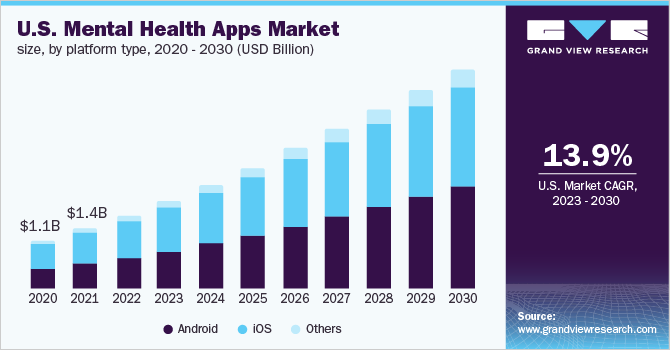 Image credit: Grand View Research (all rights belong to Grand View Research, Inc.)
Image credit: Grand View Research (all rights belong to Grand View Research, Inc.)
You’d think COVID-19 would have something to do with this trend, but that doesn’t seem to be the case. According to Apptopia’s analysis, the top 15 mental health apps have demonstrated the same growth rate during the pandemic’s peak.
So, it’s safe to say that the trend for therapy uberization is here to stay even past COVID-19. Mark my words, the mental health industry is ripe for innovations.
Key Facts on Mental Health Apps
- First-time downloads of the top 20 mental wellbeing apps in the US grew by 30% from January to April
- The majority of mental health apps (89%) lack clinical validation
- BetterHelp nearly 2x the number of app users seeking help with stress, anxiety, and other stress disorders
- In the Fiscal Year 2024 Budget, $10.8 billion has been allocated to SAMHSA.
- 2024: The market size is projected to be $7.09 billion to $7.19 billion.
- Subscription-Based Models: Expected to experience the highest growth rate.
- Meditation Apps: Projected to hold the largest market share by 2027.
- FDA has eased entry for counseling apps during the COVID-19 pandemic
- In the span of 20 years, between 2011 and 2030, the aggregate economic output loss caused by mental disorders is projected to reach $16.3 trillion worldwide.
Before discussing how to make a mental health app, let’s quickly review a few notable types and examples of mental health software.
Types Of Mental Health Applications
When you start a mental health app, understanding the different types of applications available is crucial for targeting specific user needs. Teletherapy applications allow users to engage in remote therapy sessions, making professional help accessible anytime, anywhere. Chatbots offer immediate responses for those needing instant support, while self-improvement solutions aid in personal growth and habit formation.
Other types of mental health apps include mood and symptom tracking tools, which help users monitor their mental state and recognize patterns over time. Educational healthcare services provide critical information on mental health topics, and psychological therapy apps focus on delivering structured therapeutic exercises. For more specialized needs, there are apps dedicated to managing anger, anxiety, and obsessive-compulsive disorder (OCD).
Supporting mental health requires a thoughtful approach that only custom mobile applications development can provide.
Therapy applications count and types
Since there’s no clear market definition for mental health apps, their count across the App Store and Google Play varies from 1,435 to 10,000 to 20,000 depending on whether you count meditation and other self-help apps. The most common types of mobile therapy products include:
- Teletherapy applications
- Chatbots
- Self-improvement solutions
- Mood & symptoms tracking apps
- Educational healthcare services
- Psychological therapy app development
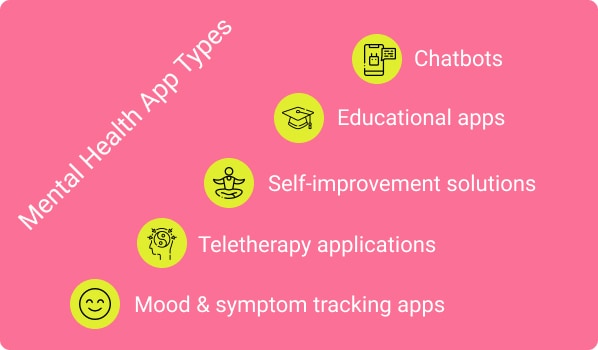
If we look at various mental conditions that such solutions tackle, we’ll note the following areas:
- anger management, anxiety management
- meditation apps with breathing exercises
- drinking & eating disorder apps,
- motivation and general mental health apps
- obsessive compulsive disorder (OCD)
- panic attacks, stress management
Of course, we’re just scratching the surface here as we can find all types of mental health software; from meal planners to mood monitoring (tracking mood swings) to even wellness apps with yoga workouts.
Creating an app for mental health also opens up opportunities to integrate features like meditation exercises, support for eating and drinking disorders, and general motivation tools. These varied applications cater to different aspects of mental health, ensuring that users find the specific support they need, whether through health insurance or direct purchase.
Top 5 Mental Health Apps
Today, the therapy apps marketplace is a Wild West. To address that, the professional community has forged several app rating platforms, such as PsyberGuide and ORCHA.
Try browsing these mobile app markets for inspiration before creating a mental health app. As they say, competitor analysis never hurts.
These rating platforms host a modest but well-vetted number of mental health apps ranked by credibility, transparency, and a few other traits. If we cross-reference these app-rating tools and pick the top 5 mental wellness products that make an appearance in all of them, we’ll end up with this list.
Happify
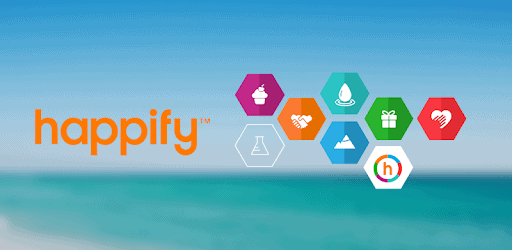
Happify is a self-improvement app that says its purpose is to make users happier. It tries to achieve that with mini-games and meditations, using a combination of mental health tracking features. For example, Happify calculates a happiness score for all users to improve their motivation and productivity.
Platforms: web / iOS / iPad OS / Android.
Monetization: in-app subscription and web subscription with varying payment plans.
Talkspace
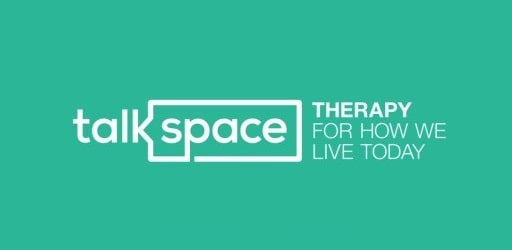
Talkspace is a telemedicine platform and, in effect, a marketplace where patients can find a matching therapist and access online therapy through messaging and audio or video consultations.
Platforms: web / iOS / iPad OS / Android.
Monetization: subscription plans.
Related: Telemedicine App Development: Everything You Need to Know
Woebot
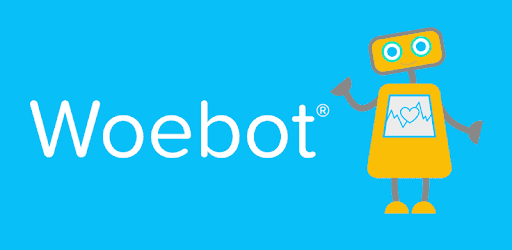
Woebot is a chatbot that serves as a perfect example of how you can create a patient app to help reduce anxiety and depression. In addition to AI-powered communication, Woebot also helps manage mental health by offering mood tracking and word games.
It’s interesting how Woebot’s AI engine uses its emergency features. For example, the word crisis triggers the bot to access whether the user or someone near needs urgent mental health treatment. These trigger checkers analyze users’ thoughts and feelings, try to identify their thinking patterns, and then provide relevant feedback to improve their self-confidence and track their mood ups and downs.
Platforms: iOS / Android.
Monetization: none at the moment (September 2022).
Related: How to Build a Chatbot
Daylio
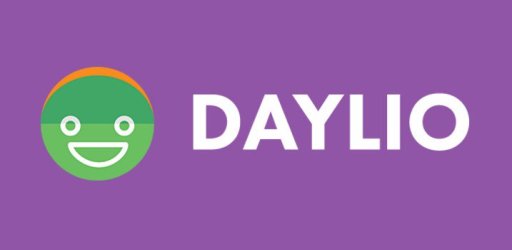
Daylio belongs to the category of self-awareness/self-assessment apps that strive to make users reflect on their mental health issues.
Daylio is a self-care journal with mood tracking and a happiness tracker. Users track their moods in relation to their activities and then review how different things affect their lives. Interestingly, this anti-depression app has become immensely popular among teenagers.
Take a closer look at Daylio if you’re developing mental health symptom tracker apps or mood journals.
Platforms: iOS / Android.
Monetization: subscription.
Headspace
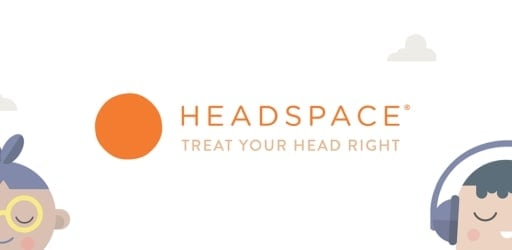
Headspace is a meditation solution with meditations for all kinds of activities and audiences. The application also keeps track of the user’s meditation practice and reminds them of scheduled sessions. The software also offers community features like group meditations, allowing participants to meditate together even at a distance, and includes a mood tracker.
Platforms: web/ iOS / Android.
Monetization : subscription.
You May Also Be Interested: How to Make a Meditation App Like Headspace
Examples of Mental Health App Features
Let’s explore the most impactful features that elevate a mental wellness app from functional to truly transformative—arranged under the updated SEO-friendly headers.
 Mood Tracking
Mood Tracking
Users today are obsessed with quantifying themselves—and mental health is no exception. Mood tracking features allow individuals to identify emotional patterns, reflect on their state of mind, and course-correct before spirals start.
Before you can present insights on a dashboard, users must first log their emotional data. That’s why any plan to develop an app to track mental health needs to prioritize frictionless self-monitoring. The less typing and tapping required, the better.
Want to inspire users with visual feedback? Tie this to a metrics dashboard.
Related: How to Build a Dashboard Web App
Guided Meditations
Meditation is often the first feature users expect in a mental wellness app—and for good reason. Guided meditations, breathing exercises, and mindfulness routines offer tangible ways to manage anxiety and improve focus. When paired with other features—like medication reminders or sleep logging—meditations help reinforce healthy mental health habits on a daily basis.
Apps like Headspace and Calm show how pairing meditations with personalized audio content can encourage habit formation. This is where personalization and thoughtful reminders play a crucial role. Even a simple nudge—“Take 2 minutes to reset before your next meeting”—can drastically reduce a user’s stress level over time.
Self-Assessment Tools
No mental counseling app is complete without tools that help users evaluate where they stand. These self-assessment features not only drive engagement but serve as a low-friction entry point into therapeutic work.
AI technologies can level up this experience through an intelligent chatbot or avatar-based chatbot like Sensely. These tools can help users track how they’re feeling, detect potential red flags, and even offer tailored exercises.
Want to go deeper? Gamified assessment test modules can blend cognitive skills training with early detection signals. These tools are also a hallmark of any serious mental disorder app, helping users and clinicians alike monitor condition severity and flag risk early.
Related: Machine Learning App Development Guide
Therapy Sessions
If you’re building a teletherapy app or telemedicine mental health app, smooth virtual therapy experiences are non-negotiable. Messaging, audio, and video calling need to feel natural and stable—even under weak connections.
Let patients book appointments easily
Sync with native calendars like Google Calendar or iCal
Support a backend patient list for session tracking
Ensure crisp audio and seamless video session flow
A well-integrated provider dashboard can also help clinicians monitor patient progress, ensuring therapy adapts over time to what’s actually working.
Also, consider secure messaging for asynchronous support. A well-designed conversational UI can bridge the gap between real-time sessions.
(Need more? Check out our take on Medical Chatbots: The Future of the Healthcare Industry.)
Educational Resources
A well-rounded mental wellness app shouldn’t just support recovery—it should educate. From curated articles to explainer videos, educational resources empower users to understand their mental health disorder better.
This includes everything from anxiety to bipolar disorder, attention problems, and even schizophrenia. Cover topics like diet, tracking allergies, or identifying signs of disorder aggravation. Educational content helps users take proactive steps in managing their well-being.
Need inspiration? Our guide on how to build an education app shares ways to turn passive content into active learning experiences.
Breathing Exercises and Relaxation Techniques
From calming breathwork synced to music to simple body scans—these features are small but mighty. They’re particularly effective for addressing stress, post traumatic stress disorder, or disorder aggravation in the moment.
Tie in sleep tracker integrations to personalize these techniques based on sleep patterns or fatigue signals. This data-driven feedback loop makes your app feel truly responsive.
And remember: guided relaxation exercises can be an on-ramp to deeper therapeutic engagement.
Community Forums
Social networking features are more than just feel-good extras—they’re sticky mechanisms for engagement. Creating a live feed where users share thoughts, comment, or vote on mental health topics encourages peer support and normalizes discussion.
Done right, community can reduce stigma around LGBTQ bullying, suicide prevention, or lesser-discussed conditions. Just be sure to include moderation tools and mental health disclaimers.
Community forums are also a great channel for surfacing user feedback, surfacing feature ideas, and building long-term engagement loops.
Mental Health App Benefits
Today it’s common knowledge that healthy people are no longer defined by a healthy heart rate alone. Mental disorders can have devastating effects on people’s health, and therefore proper patient care is essential to keep a nation’s health in check.
Learn more about artificial intelligence nursing burnout and its role in supporting mental health professionals.
It’s hard to imagine mental health applications replacing traditional therapy altogether. At the same time, there are undeniable benefits of using these products as temporary replacements for a traditional treatment process, which is why healthcare app development has seen a surge of late, especially during the COVID-19 pandemic.
Here are some advantages and handicaps of mental counseling solutions:
Pros
- Instant access (anywhere, any time)
Mental health specialists can help users of mental healthcare software anytime, without a hospital visit.
- Lower cost compared to face-to-face sessions
Minor mental health problems like heartbreak can be dealt with by applying online therapies or AI consulting found in self-improvement apps: e.g., self-help for anxiety management.
- More control over health data for patients
Customers not only get full access to the history of their mental health illnesses but can also check how consistent they’ve been with medicines.
- Easier to overcome stigma
Some patients feel more comfortable when they can get even rudimentary help from AI bots and only have to deal with humans in case serious intervention is required.
Learn about fitness mobile app development in our dedicated blog.
Cons
- Necessity to educate patients about new technologies
- Challenges related to lack of trust
- Limited confidentiality of sessions
- The amount of effort it takes to get the evidence-based status
Monetization Strategies for Mental Health Applications
Mental wellbeing solutions are no strangers to all the regular monetization options available for mobile apps out there:
- Paid premium version
- In-app purchases
- Mobile ads
- Subscription
- Freemium app model
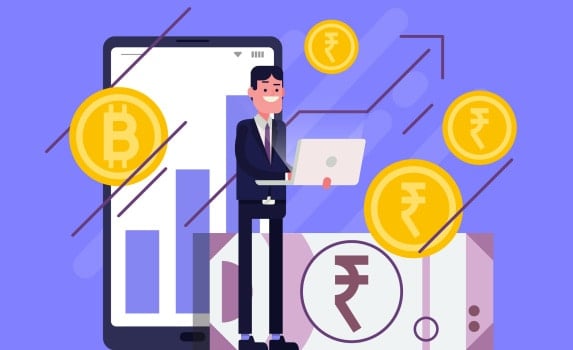
However, if we look at the top-performing mental health apps, we’ll notice that most of them stick with subscription payments. That must have to do with the fact that today we’re living in a subscription economy, where the price of ownership extends over time. Apple itself admits that the subscription revenue model generates for apps more money.
What we do not see with these solutions, though, is in-app purchases for users to try out a mini-game, a session, or any other meaningful interaction or content. It seems like a no-brainer, and yet we haven’t noticed a single application do that.
One other thing to note is that often, when users subscribe outside the application, on a company’s website, they get 30% discounts that would end up in Apple’s or Google’s pockets. So it makes sense to find ways to bypass adding a subscription-based monetization method right in the app.
Also, note that advertisements (if you favor ads among all other monetization methods), should never interrupt the user experience. Other than that, the advertising business model seems completely legit. Think discreet advertising banners or something similar, and mix and match in-app offers.
Anyways, a monetization model will be irrelevant if you don’t follow the best practices. So keep reading to review them.
Key Aspects of Mental Health App Development
Before you dive into sprints and Gantt charts, it pays to map out what actually makes a mental health app work—not just technically, but clinically, emotionally, and commercially. From choosing the right backend stack to understanding what triggers user drop-off, here’s your mental health app starter kit, broken down.
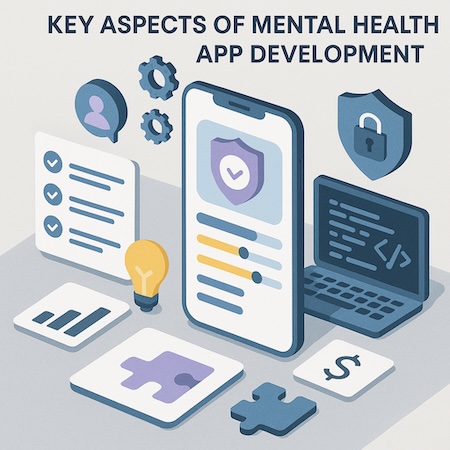
Identifying the Target Audience and Their Needs
Teenagers dealing with social anxiety. Veterans coping with PTSD. Therapists managing burnout. Each group brings wildly different expectations. Start by narrowing your scope—who are you building for, and what outcomes do they want?
Run surveys and 1:1 interviews to define use cases
Study Reddit threads, app reviews, and user complaints
Don’t just ask what users want—ask why they’re quitting current solutions
It’s also wise to get clinical advisors involved early to avoid building a glorified to-do list app with a meditation sticker slapped on it.
Defining the App’s Purpose and Functionalities
Not all mental health apps need mood tracking, AI chatbots, or virtual whiteboards for journaling. Focus on one “core job”—supporting recovery, guiding CBT-based exercises, enabling 24/7 access to a therapist—and build around that.
Pro tip: one core feature that works > ten that kinda do.
Choosing the Right Technology Stack
Cross-platform is often the fastest way to market (React Native or Flutter are solid picks). If you’re leaning into AI, you’ll want Python for the backend and secure GPU-ready infrastructure. Planning for EMR integrations? Think FHIR support, OAuth2 for patient auth, and HIPAA-safe cloud services like AWS or GCP.
Avoid shiny object syndrome—choose tools that scale and keep development cycles lean.
Ensuring Data Security and Privacy
This one’s non-negotiable. If you handle PHI (Personal Health Information), you’re bound by HIPAA in the US and possibly GDPR elsewhere. Encrypt everything, at rest and in transit. Bake in access controls from day one. And yes, that means avoiding Firebase or Airtable for storing anything remotely clinical.
Better yet, work with vendors who offer signed BAAs and compliance out-of-the-box.
Developing a User-Friendly Interface and Engaging Content
Mental health apps aren’t productivity tools. Users may be in distress, distracted, or on the verge of closing your app forever. So design for clarity and calm:
Use muted tones, readable fonts, and large touch targets
Avoid unnecessary animations or gamification unless they serve a therapeutic goal
Localize content and diversify visuals to feel inclusive
Interactive check-ins, mood tracking streaks, or audio-guided mindfulness sessions are more useful than a “level-up” badge.
Testing and Iteration
Ship fast, but don’t break trust. Beyond functional testing, mental health apps benefit from:
Usability testing with neurodiverse users
Clinical review of content and flow
Data privacy audits
If users report confusion, hesitation, or unease, take it seriously—it’s a sign you may be doing harm, not good.
Implementing a Sustainable Monetization Strategy
You’ve read about subscriptions and freemium models. But think beyond user payments:
Partner with employers for EAP integrations
Explore partnerships with digital clinics or payers
Build a CPT-coded tool and work toward reimbursement eligibility
Just avoid surprise paywalls. Nothing erodes trust faster than offering help, then hiding it behind a checkout screen mid-crisis.
Planning for Ongoing Maintenance and Updates
Mental health content and clinical practices evolve. So should your app. Plan quarterly releases, rotate therapeutic content, and budget for ongoing vulnerability testing.
Plus, once you have users relying on your product for their emotional wellbeing, every feature you ship (or break) has higher stakes. Treat your backlog like a care plan.
Mental Health App Development Best Practices
Before we take you through the steps of how to develop a mental health app, let’s talk about what will make your solution stand out.
Consumer-Centric design
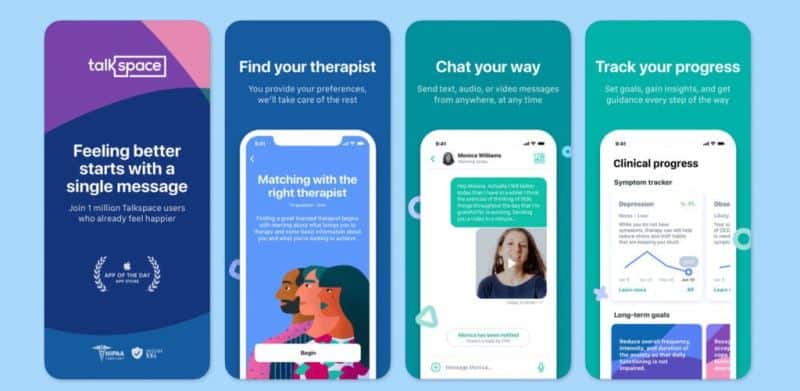
From your app’s logo through onboarding and to main screens, the design is your primary tool for establishing credibility and trust.
- How smooth is the onboarding process?
- Is it immediately apparent to users what they can do in the application?
- Does the UX follow the platform trends, simplifying user interactions?
Answers to these and other similar questions will help you understand whether your application will win users’ hearts or leave them indifferent.
Speaking of appeal, remember that your solution needs to remain accessible to people who might be discouraged by overly vibrant or unnecessary dim design.
Read our guide to Healthcare App Design
Also read: How to build a Pharma App: The Ultimate Guide
Security
Naturally, people will care about how well your product is protected because their personal information will be at stake. So I recommend that you take security measures implementation seriously from the get-go, like with other healthcare apps.
So, what can you do besides HIPAA compliance to mitigate this pain point? For one thing, have a transparent privacy policy and educate your users about security best practices. You must also comply with regulatory guidelines like GDPR in the EU. Therefore, seek guidance from local authorities.
Besides that, you should always have an SOP in case security vulnerabilities are detected.
Doctor-Centric back end
Remember that therapists will also be using a web or mobile app to interact with patients and a separate solution to review patient data, track their progress, etc. Think dashboards’ realm.
Multi-Platform support
These days, a customer typically switches between at least two devices throughout the day: laptops and smartphones. Throw in a tablet or a smartwatch if it’s a tech junkie.
And though it may be hard to pull from day one, your product should manage to follow the customer accordingly on all these platforms.
Internet of medical things
Never underestimate the data you can get from wearables and smartphones pertaining to physical activity of customers. As you’re well aware, a healthy mind requires a healthy body. Catching discrepancies in patients’ activity early on may help create a better treatment plan.
Also Read: IoT App Development Guide
Interoperability
Mental health data should be able to flow freely from a mental well-being application to other mental health professionals’ psychiatry systems, e.g., EHR/EMR. You’ll never know what partnership opportunities will come knocking on the door unless you make patient data readily available for secure, anonymized sharing.
Related: EMR/EHR System Development Guide
Cautious use of AI
AI can make or break your therapy app. With this type of application, you can’t rely on training your healthcare machine learning algorithms on real patients. And there should always be an option for seamless human handoff. We know examples of AI engines that recommended a glass of bourbon to relax.
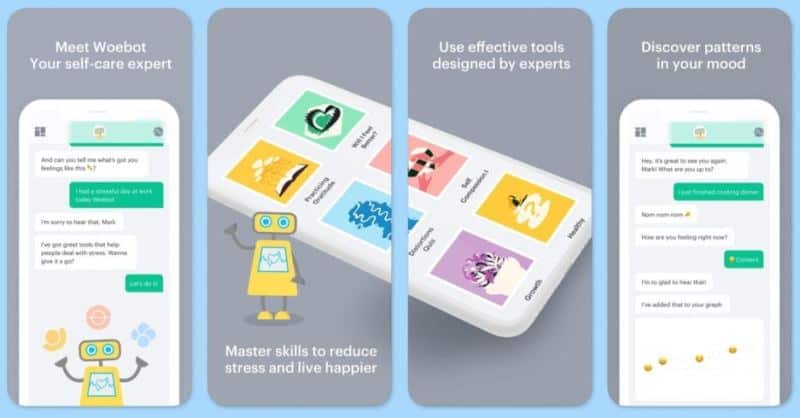
Psychiatric emergency
Finally, remind patients that your solution is not designed for an emergency (God forbid, suicide attempts) and provide appropriate contacts in the app for such situations. Emergency support features should be limited to a simple call button and maybe a short FAQ section and automatic notifications for family members and relatives. As for emergency messages, it’s not recommended unless you can provide uninterrupted 24/7 service with human support.
In order to develop a mental health application successfully, adhering to these best practices is essential.
Step-by-Step Guide on How to Create a Mental Health App
Ok, now let’s jump into how you actually make a mental health app.
Creating a mental health app requires a well-structured process to ensure the final product meets both user needs and compliance standards. By breaking the journey into manageable steps, you can streamline development and focus on delivering a meaningful solution.
From understanding your target audience to coding and testing, each phase plays a crucial role in shaping the app’s success. Here’s how you build a mental health app, step by step:
- Step 1: Choose the target audience and platforms
- Step 2: List possible features and run rapid prototyping
- Step 3: Code the solution for patients and doctors
- Step 4: Test the application
- Step 5: Release the app and keep updating it
| Step | Description | Key Actions |
|---|---|---|
| Step 1: Define Audience | Identify your target users and platforms for the app. |
|
| Step 2: Plan Features | List and test potential app features using prototypes. |
|
| Step 3: Start Coding | Develop the app with a focus on technical and compliance needs. |
|
| Step 4: Test | Ensure the app is fully functional and meets quality standards. | conduct functional, performance, security, and other tests |
| Step 5: Launch & Improve | Release the app and continuously update it based on feedback. |
|
| Following these steps ensures your mental health app is user-focused, compliant, and ready for market success. | ||
Step 1: Choose the target audience and platforms
Whether your app will target seniors, adults, or teenagers will impact your choice of platforms. It certainly helps to know more about your intended patients to design relevant experiences when making a mental health app. Some of the things to cover during research include:
- identifying the customer age group that the app aims to help
- competitor research to define the target audience’s expectations
- prepare a typical patient profile
Ideally, a few customers from your TA will partcipate in the next step and help you narrow down on the UX/UI of the solution.
Step 2: List possible features and run rapid prototyping
When it comes to custom developing an app, having a list of features and testing them with a prototype allows you to verify your app design ideas and ensure that the product will work as intended.
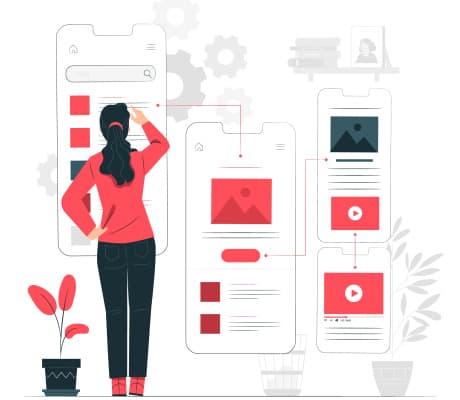
Creating a prototype first not only helps you save 10x the cost as compared to jumping directly into product development but can also significantly reduce how long it takes to build your app. Essentially, you get to validate your business idea with zero coding (the most expensive part of mental health software development).
Please note that developers should also take part at this stage to verify the technical feasibility of the prepared designs.
As an alternative, you can pick a no-code scenario at this stage and use stock interface elements to put together a prototype for testing. In this case, test users will review the software on their mobile devices.
Step 3: Code the solution for patients and doctors
This part will take the bulk of development time. We recommend following the Agile principles and going through interim tests with each iteration. Follow these tips to guarantee a timely delivery:
Read our guide on how to find and hire mobile app developers
- Use third-party HIPAA-compliant audio/video calling SDKs if you’re building a telemedicine therapy app
- Use other off-the-shelf components, like a chat with audio messages, to expedite delivery
- Setup the DevOps pipeline to free developers from spending time on non-essential tasks
- Follow cybersecurity best practices according to HIPAA regulations
At Topflight, we have always strive to lower the tech barrier (and lower the cost accordingly) by using available components. Over a few years, we’ve assembled a fine collection of ready-to-use libraries for authentication, appointment scheduling, chatting, and other prerequisite features, common for most applications.
Related: HIPAA Compliant App Development: The Ultimate Guide
Step 4: Test
As we’ve mentioned, testing is an intrinsic part of the development process. However, this step describes a major testing effort that takes place before releasing the solution. You’d need to go through such things as:
- Functional testing
- Performance testing
- Compatibility testing
- Interface testing
- Unit testing
- Stress testing
- Security testing
Related: Mobile App Testing: Methods, Best Practices, Tools and More
Step 5: Release and keep updating
Once your application has been thoroughly tested, it’s ready to welcome users. A round of app store submission tremors (if you’re lucky or if you’re working with pros), and the app is out, hopefully, accompanied by a mobile marketing campaign.
Now it’s time to track its performance with the in-app analytics tools you implemented during development, address user concerns and requests, fix issues, and keep the application updated. Remember to set up a sound DevOps strategy to keep the maintenance costs down.
Once launched, the app will feed you user engagement data, provided that you added Google Analytics or similar service at the development step. This data will drive further mobile software updates by helping you identify new growth areas.
Following these steps will ensure your app stands out in the competitive market of mental health applications development.
Tech Stack for Mental Wellness Apps
You’re absolutely fine with practically any technology stack for therapy app development. I frankly struggle to name technologies that would stand in your way. Just make sure your software development partner chooses technologies and frameworks based on your software product’s requirements.
One thing you’ll need to decide for sure is whether your solution will have a cross-platform architecture. If that’s the case, you can’t go wrong opting for React Native or Flutter. These frameworks provide outstanding data security capabilities, including encryption and other data protection tools. In addition, you get the flexibility to reuse code to support the web platform.
Native mobile technologies, e.g. Swift for iOS and Kotlin for Android, make sense if you plan to add on-device machine learning capabilities or use advanced features of the mobile platforms like AR/VR.
As for the app server, I’d recommend sticking with Node.js and AWS services. Also, think through the integrations required for the application. For instance, if your business plan includes integration with a CRM for data recording, you’ll need to build an API. Better yet, if your CRM platform already supports APIs for app data integration out-of-the-box.
10 Takeaways from Negative Reviews on Mental Health Apps
If you really want to learn how to create a mental health app that leaves your competitors behind, take note of these reviews left by frustrated customers.

- Check all login options. While social logins like Facebook or Twitter may work fine, some new authentication techniques like Apple ID may prevent users from logging into the app.
- Think through each user experience element: If the user doesn’t know why she earns points, there’s no reason to keep them.
- Find the balance between upselling a subscription and offering value to users.
- Make sure the design is stellar.
- Onboarding does matter.
- Check that security is not standing in the way of simplicity.
- Be clear about the pricing policy and then provide 5-star customer support.
- Weed out bugs, obviously.
- Make sure the product supports the latest mobile OS and all screen sizes.
- Include new stuff for long-time users to keep them engaged.
Top Concerns Mental Wellness Applications Need to Handle
Trust building
First and foremost, users should be trusting your app because they’re going to share their personal information. So every little detail, including privacy policy, bio authentication (with a fingerprint or face id), and built-in extensive knowledge base, should be given careful consideration.
Clinical evidence
People will need to know whether your app is backed by real-life research and if there is clinical evidence for its effectiveness.
Engagement
We’ve noticed that solutions that have the best scientific base usually fail to provide highly engaging experiences. One other thing to mention is that some of these applications need to rotate content regularly to keep user retention high.
Stigma
I agree that a mental health app can relieve the social stigma of asking for psychological help to some degree, but you still need to be conscious about copy and design of your application.
In conclusion, tackling these concerns effectively will help in how to build a mental health app that not only meets users’ needs but also establishes a lasting, positive impact in their lives.
Mental Health App Development Cost
The cost of developing a mental health app varies depending on the scope of the project, the app’s type, and the number of platforms you are planning to support. If we are talking about a teletherapy app, its cost may start at around $140,000. If it’s a relatively simple mood tracking app (for following mood patterns) with self-monitoring features — $70,000. I’m certainly talking about an MVP version here- something you start with and build upon later on.
Like with other mobile software, we noticed that owners often forget to include the back end into the cost equation. You will definitely need a database and probably some admin area to manage content, etc. So make sure your app developers include this into their price when working on a quote for your mental illness app.
Related Article: Understanding App Development Costs, Healthcare App Development Costs
Our Experience with Mental Health App Development
To date, Topflight’s experience in mental health app development includes at least three projects that qualify as mental health apps: an AI coach, a chatbot, and a couple of meditation applications (one of which has already been released).
XZEVN
We built a content recommendation engine that helped individuals maintain emotional health and improve their time management, decision-making, and goal-setting.
On the user-facing front, you’d input your daily emotions via chatbot conversations, respond to daily questions, and like or dislike recommended articles and famous quotes. The solution does not come up with a diagnosis, instead working as a personal diary tracking mood changes. And the treatment team gets insights from user interactions through a connected admin web application.
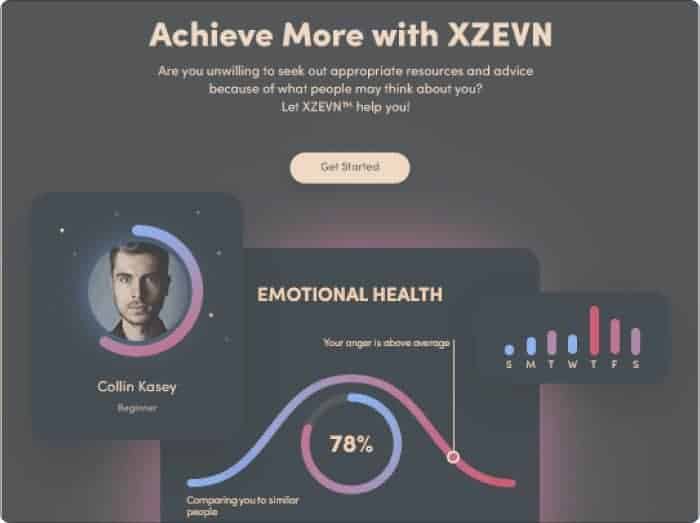
Here’s a link to the case study where we talk about how our approach helped the client get into a business incubator.
Soberbuddy
Soberbuddy is a chatbot that helps people on the addiction recovery journey (alcohol & drug abuse). This software helps customers follow evidence based mental health practices focused on relapse prevention: cognitive behavioral therapy and mind-body relaxation techniques.
Related Article: Addiction Recovery App Development
We inherited the project from a different team that was overcomplicating things by adding unnecessary machine learning blocks. On top of that, they didn’t find much success in helping the client monetize the product. By the way, since Topflight got involved, the project’s funding reached $1.25m.
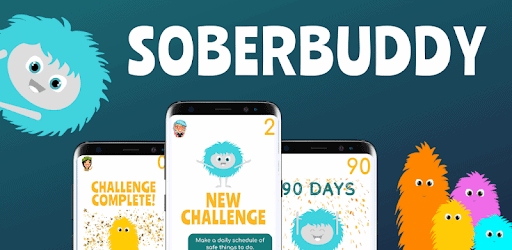
After our intervention, Soberbuddy has achieved a 10% subscription rate, a 25% retention rate, and a close to 100% activity rate. We keep working on the software, trying to apply technologies unlocking additional treatment methods, for example, group therapy techniques.
Here’s the case study if you’d like to learn how we did that. The story will also teach you how to start a mental health app grounded in cognitive behavior therapy right on the first go:
- Raised: $1 million since partnership
- Boosted: retention by 300%, increased average engagement time by 40%
- Boosted: app store from 3 to 4.5
- Boosted: user count to 30,000
- Reduced: cost of acquisition by 50%
Respirosa
The mobile software offers quite unique meditation techniques: this mindfulness application helps customers practice breathwork while listening to their favorite music and following visual clues synced to the beat.
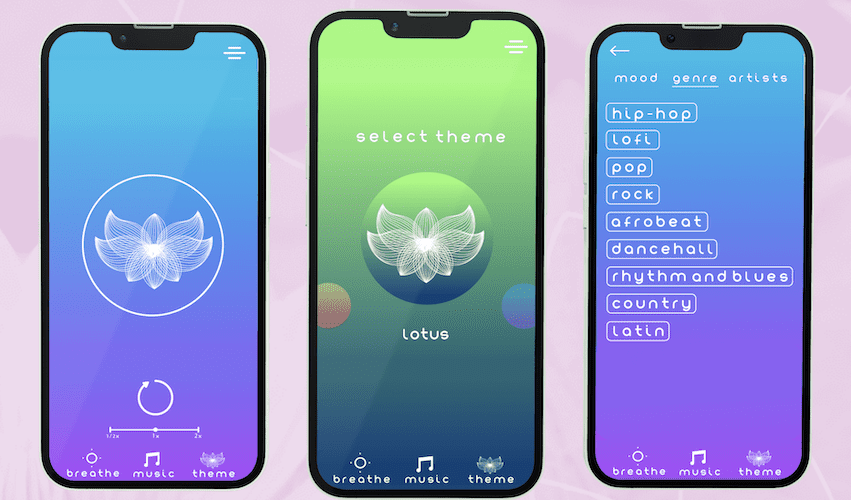 Users pick a tune by mood, genre, or artist and choose a color theme. The software then plays the song from the user’s music selection on Spotify and guides users through breathing sessions with an animation adjusted to the tempo of audio content.
Users pick a tune by mood, genre, or artist and choose a color theme. The software then plays the song from the user’s music selection on Spotify and guides users through breathing sessions with an animation adjusted to the tempo of audio content.
Reach out today if you want to develop a mental health app or learn how your mental health app can shoot straight past the competition.
Related Articles:
- A Guide to Building a Mental Health Chatbot
- Healthcare App Development Guide
- How to start a healthcare startup
- How to Create a Telehealth App
- How to collect healthcare data for your mobile apps
- Building Healthcare Apps that Improve Patient Data
- Artificial Intelligence in Healthcare
- How to build a doctor appointment app
- Wearable Technology in Healthcare
- Building Healthcare Chatbots
[This blog was originally published in September 2020 and has been updated for more recent data]
Frequently Asked Questions
How much does it cost to develop a mental health app?
$40,000 to $80,000, depending on its specifics; reach out to find out how much your counseling application may cost.
What tools should I consider to build a mental health app that relies on AI?
You may look at PyTorch, Dialogflow, RASA, Microsoft Bot Framework — there’s plenty to choose from.
Do I need to provide any certificates to list my mental health solution in app stores?
Not at the moment.
How long does it take to build an average mental health tracker app?
3 months.
Does my mental fitness app require to be HIPAA compliant?
If it stores any protected health information, yes.
How do I build a mental wellness app that's engaging and personal?
Consider using AI frameworks and adding a chatbot that learns from discussions with patients.
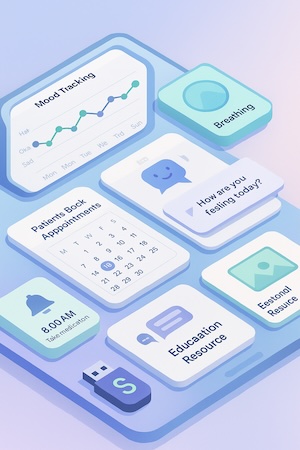 Mood Tracking
Mood Tracking
